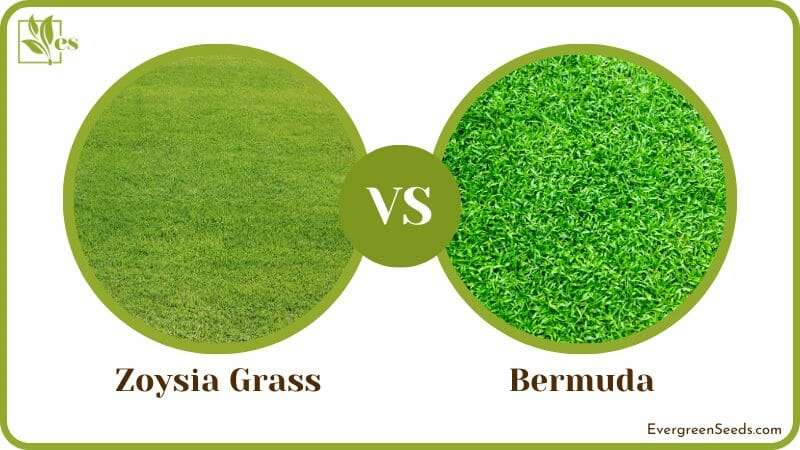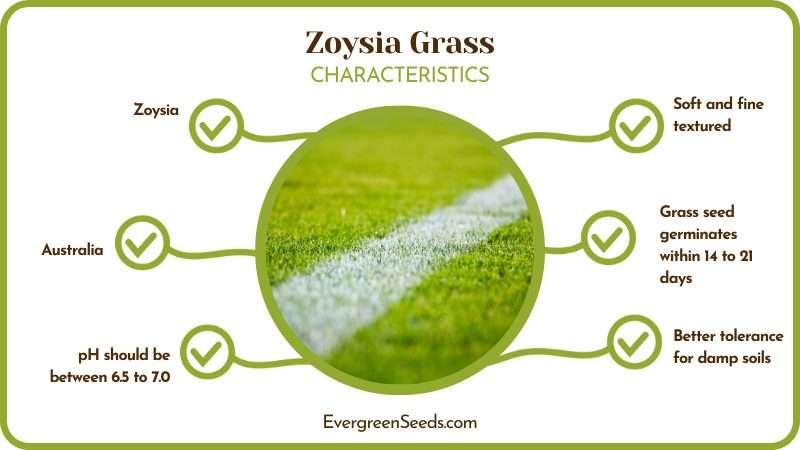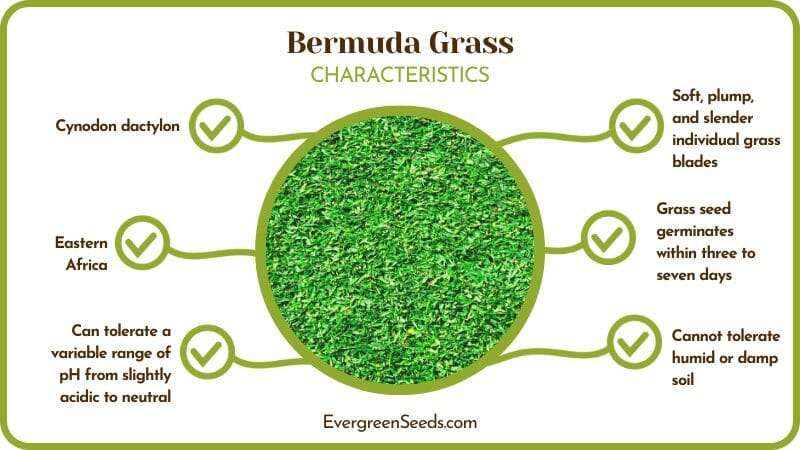- 10 Shrubs for Privacy: Top Picks for a Secluded Garden - October 11, 2024
- Overwatered Zucchini Leaves: Causes and Solutions for Healthier Plants - October 11, 2024
- What Do Overwatered Impatiens Look Like: Identifying Signs and Solutions - October 11, 2024
Zoysia grass vs Bermuda grass is a tough competition between two of the most sought-after warm-season grasses. Can’t decide which one would suit your house and lifestyle the most?

No need to worry, as we have clearly outlined all these grass varieties’ major pros and cons in this article. We also have a comparison guide between Bermuda Grass and Kentucky Bluegrass. Find out which of the two has better growth potential and which one is easier to maintain by carrying on reading below.
| Features | Zoysia Grass | Bermuda |
| Uses | Landscape, golf courses, backyards, lawns, turfs | Gold courses, tennis courts, residential lawns |
| Appearance |
|
|
| Germination and Growth Rate | Grass seed germinates within 14 to 21 days | Grass seed germinates within three to seven days |
| Temperature Requirements | 65 to 70 degrees Fahrenheit | 95 to 100 degrees Fahrenheit |
| Light Requirements |
|
|
| Soil Requirements |
|
|
JUMP TO TOPIC
What Are the Main Differences Between Zoysia Grass and Bermuda?
The main difference between Zoysia grass and Bermuda is that the former is medium-green and more tolerant toward partial shade and damp soil. Bermuda is light-green in appearance and needs full sun. It is invasive in nature, and it germinates and spreads much faster than Zoysia.
Zoysia grass is a popular choice, especially among people new to the art of lawn care. It also grows thicker, and it’s easier to maintain. On the other hand, Bermuda is hardier, so it may be a better choice for areas predisposed to droughts.
Zoysia can grow and develop well even when the sun exposure isn’t ideal at your location. It can tolerate partial shade of up to 40 percent well. Bermuda isn’t that tolerant and will start to fade and turn yellow if it doesn’t get enough light per day.
However, if you have dogs at home, Bermuda seems to be the safer choice. It’s not as thick as Zoysia, and it is more resistant to dog urine, so you don’t have to worry about yellow patches if your dogs frequently pee on it.
If you’re struggling with weeds, then Bermuda might be a better choice. It is actually considered an invasive species, and it can easily overcome other weeds. This can help maintain a lush and uniform lawn.
What Are the Main Characteristics of Zoysia Grass?
The main characteristics of the warm-growing Zoysia grass include that it is drought- and cold-tolerant. However, it can only tolerate up to 40 percent shade and will not fare well in a more shady area. It’s also a low-maintenance type of grass.

– A Warm-Season Grass With Cold Tolerance
This grass falls into the category of warm-growing grasses. This means it can tolerate higher temperatures and will go dormant under cold weather conditions. The preferred temperature range for this turf grass is 65 to 70 degrees Fahrenheit.
Unlike most similar grasses, this one is able to withstand colder temperatures and might even stay green all through winter. This will only happen in the case of mild winters, though.
This grass will go dormant in winter when temperatures drop below 55 degrees. It might even die if they drop below zero as their roots underground will freeze off. The grass seeds germinate in early spring as soon as the weather starts to warm.
The Zoysia grass seeds take three to four weeks to germinate. By late spring, all the grass blades will have turned green.
– Zoysia Is Low Maintenance
This grass requires the lowest possible lawn maintenance to keep looking fresh and lush. Its root system develops aggressively deep into the ground. Underground rhizomes are able to store water for a long duration of time. You will not have to water it if it has rained any time in the past two weeks.
You can mow this grass as low as 1.5 inches long. This mowing height means you will only have to mow it once every ten days or every two weeks.
Weeds will not be a problem when it comes to this grass. Its competitive growth habit means it will starve any weed it tries to establish in its territory. Within a year or two, Zoysia establishes itself very thickly and does not even let occasional weeds sprout up uninvited.
– Thick and Traffic-Tolerant
Zoysia is a grass lawn that grows very thick in a short period. It is also able to tolerate foot traffic over it relatively well. This is good news for homeowners in the warm southern regions. They get to plant this lush grass on their lawn and have kids and pets play on it. You can also invite all your friends over for a barbecue.
The grass blades will spring and will not get damaged in most cases. Even if they do incur some damage due to constant trampling, Zoysia has the ability to repair itself fairly quickly.
We all want to ensure our grass stays evergreen and healthy despite moderate footfall. Regular watering and fertilizing the lawn are a must to ensure this. Zoysia needs only one inch of water per week, which is not a problem in most cases. Moreover, fertilizing with a balanced formula in early spring is a must.
– Will Remain Green Even in Drought
This grass grows best in the warm and transition zones of the United States. Naturally, this means that it must be resistant to drought instead of being resistant to heat. It will carry on growing with as little as half an inch of water per week.
Without any rain or supplemental watering on your side, this grass can live up to four weeks. It might go dormant but still retains its fresh green color. This is all thanks to its extensive underground network of rhizomes that store water for a week’s worth of use.
In prolonged drought, even infrequent watering using a very small quantity of water should be able to keep this grass going. You have little to worry about with Zoysia as your turf or lawn grass.
– Only Slightly Shade Tolerant
Like most other warm-growing grass varieties, Zoysia also likes to grow under full, bright sun. However, its shade tolerance allows it to grow healthily in up to 40 percent shaded conditions.
It will refuse to grow and spread to a region completely shaded from natural light. However, conditions of partial shade are only slightly acceptable.
Overseeding Zoysia with shade-loving grass will ensure that all portions of your turf are covered by grass.
What Are the Main Characteristics of Bermuda Grass?
The main characteristics of Bermuda grass include its ability to tolerate drought and foot traffic and repair grass blades that have been damaged. It is also one of the cheapest grass varieties to grow and maintain. However, it will not grow well in shaded areas.
– A Classic Warm Season Grass
Bermuda is a grass that grows well in hotter regions. The ideal temperature range for this grass is between 95 to 100 degrees Fahrenheit, and its grass seeds need a minimum soil temperature of 65 degrees in order to germinate.
Your Bermuda grass blades will turn green at the onset of spring or even late spring. They will stay fresh and green throughout the months of summer. What this grass cannot tolerate at all is cold weather and frost.
In moderate winters, Bermuda will undergo dormancy and re-seed the next spring. Very harsh winters, when temperatures fall below freezing, will kill the underground rhizomes of Bermuda. The grass will not return next spring.
– It Is Drought Tolerant
No other grass compares to Bermuda when it comes to superior drought tolerance. This property comes especially handy during the hotter months when water becomes sparse for lawn maintenance.

Having a shortage of adequate water in your neighborhood should not stop you from keeping a lush lawn. It will survive and carry on thriving with as little as one-quarter of an inch of water per week. Furthermore, it will survive without water for at least three to four weeks.
Even Bermuda grass will turn brown if an absolute drought persists beyond four weeks. This is your grass’s way of telling you that it has undergone dormancy. Do not worry, as establishing regular watering will revive your lawn in no time.
– It Is an Invasive Grass Type
Bermuda is a creeping and invasive grass that can get out of control if not constantly regulated. It grows above ground by stolons and underground by means of rhizomes. It spread half an inch a day on average.
Couple its invasiveness with its competitive nature, and you have grass that will not let any other plant establish itself within your lawn. Its ever-growing roots will consume all the water and nutrients in the soil.
That is why it is important to use a pre-emergent herbicide in lawn parts where you do not want Bermuda to spread. The best time to apply such a herbicide is during early springtime. If you see your grass extending regardless, use a rake to pull it out via the roots and rhizomes.
– Can Tolerate Heavy Traffic
You sit, walk, or run around over a lawn carpeted by Bermuda all you want, and this grass would not get damaged. Its leaf blades are super resilient and spring back up when walking on. It also has the best healing ability so that even if some parts of the grass get damaged, they are soon repaired back to normal.
The same happens in the case of mowing. Even if you mow the leaf blades small, they will grow back in record time. Ensure that your grass is kept properly fed through regular watering and feeding.
Fertilize a Bermuda lawn in early spring when the seeds are about to germinate. A balanced or a nitrogen-rich fertilizer are both good options. When using liquid fertilizer, always dilute it to half-strength as a precautionary measure. This will save you from accidentally burning your grass chemically.
– A Reasonable Grass To Maintain
Bermuda is one of the cheapest grass types in the market. Compared to other popular types, Bermuda seeds, plugs, and sod barely cost a fraction of the money.
Planting and lawn care with Bermuda is also relatively cheaper and reasonable. This is not grass that needs a lot of water, feed, or any other kind of upkeep.
It also competes with weeds and prevents them from sprouting. You get to save money on weed maintenance as well.
– Cannot Tolerate Shade
At least eight hours of intense sunlight are needed to grow the healthiest Bermuda. That is why you cannot sow it in turfs and shaded lawns that receive no direct light.
Even if a particular lawn receives partial direct light for a few hours a day, you will see that your Bermuda is not as vibrant or fresh looking as it should be.
Some parts of turf or lawn are under the shade where Bermuda will not grow. You can mix Bermuda seeds with shade-tolerant grass and plant these.
– Will Grow in All Soil Types
It does not matter if your turf is made of clay-like compact soil or your lawn is composed of loose, sandy soil. Bermuda grass can grow successfully in all types of soil and establish itself fully.

It survives both acidic and alkaline types of soils equally well. It is one of those few grass varieties that can tolerate salt water without dying or going dormant. No wonder you will find many homes, public parks, and golf courses in coastal areas carpeted with this grass.
Final note:
A common example is a lawn with St Augustine overseeded with Bermuda. Unless Augustine grass is mowed low, it will soon be choked out by Bermuda.








